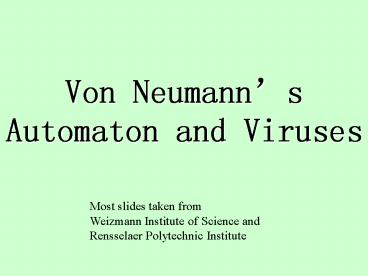Von Neumann PowerPoint PPT Presentation
Title: Von Neumann
1
Von Neumanns Automaton and Viruses
Most slides taken from Weizmann Institute of
Science and Rensselaer Polytechnic Institute
2
The General Question
- What kind of logical organization is
- sufficient for an automaton to control
- itself in such a manner that it
- reproduces itself?
3
Von Neumann Neighborhood
2
State of the cell at time t1is calculable from
its state and its four non-diagonal neighboring
cellsat time t.
3
1
5
4
4
States in Von Neumann Automaton
- Each cell is capable of 29 different states.
- Each state is excited or unexcited.
- Movement of data on the cellular lattice is
determined by the changes of unexcited and
excited states in cell. - Cells change at discrete times according to the
transition rule.
5
Ordinary Transmission States
4 unexcited states
4 excited states
6
Quiescent State
cell in the quiescent state
cell in the ordinary transmission
state
- Cells in the quiescent state U
- have to be excited with more
- than one signal directed to them.
7
Confluent States
8
C10 and C01
C00
C00
0
0
C00
C10
1
1
0
C01
C01
1
C10
0
C00
C11
1
C11
t
9
C00
A not excited cell at the input of a confluent
cell
All of the cells in ordinary transmission states
pointing to cell in confluent state have to
be excited.
10
C11
C01
t
Two dots inside
The number of dots in the number of dots out
11
Pulser
- A pulser P(i1, i2 ,, in) is used to encode a
sequence of signals so that a single excited
signal entering the input cell will produce the
sequence i1, i2 ,, in at the output cell.
output
at time t through t n
input
at time t
12
Pulser(10101)
C
C
C
C
13
Decoder(1x1x1)
- A decoder produces a single signal if the
sequence it receives has signals in specified
positions.
14
Repeater
Repeater repeats the sequence of signals until it
is turned off.
10
10
01
01
construction process
15
Special Transmission States
4 unexcited states
4 excited states
They are similar in operation to
ordinarytransmission states, but they
convertconfluent states to quiescent state.
Special transmission states are denoted by double
arrow notation
16
The Destruction Process
- The destruction process transforms unexcited
- and excited states into the quiescent state in
- single step.
t
t1
17
Sensitive States
They are intermediary states converting quiescent
state into one of the 9 unexcited states
C00
18
The Sensitized Tree
19
The Construction Process
t
20
(No Transcript)
21
Periodic Pulser
C
C
C
C
C
C
P(11111)
C
S111
C
P(10101)
Repeater
C
C
C
22
Coded Channel
Ddecoder Ppulser
23
Transition And Output Table
24
Automaton
o0s0, etc
25
Finite Automaton
26
Constructing Arm
27
Horizontal Advance
28
Horizontal Advance of Constructing Arm
29
Vertical Advance of Constructing Arm
30
Horizontal Retreat of Constructing Arm
31
Vertical Retreat of Constructing Arm
32
Injection of Starting Stimulus
33
Reading Loop
34
Constructing Arm
35
Universal Computer
36
Universal Constructor
37
Automata Self-reproduction
38
Automata Self-reproduction
39
Automata Self-reproduction
40
Cellular Automata vs Viruses
- Cellular Artificial Life
41
Virus Definition
- A simple computer program that attaches itself to
a legitimate executable program, and reproduces
itself when the program is run. - Trojan Horse no self-replication
- Worm infects through security hole, then
self-replicates through idle memory
42
Virus Types
- Boot sector viruses
- Infects boot sector on diskette
- Replaces it with replicated copy of virus
- Hides in memory, infects all new disks
- Executable Viruses
- Resident, direct action or a combination
- Resident remains in memory and attacks every
program run - Direct action may search for a new file to infect
43
Virus Categories
- Parasitic spread on program execution through
storage and transmission medium - Multipartite infects both boot sector and
executables - Stealth hidden in memory to infect or redirect
interrupts - Polymorphic uses encryption to change signature
for each replica - Dropper places boot sector infector on disk
44
Computer vs. Biology
- String of genetic material vs. instruction set
- Neither capable of self-replication outside of a
host - Takes over cell and uses it to spread virus
- Unexpected and uncontrollable replication makes
viruses (of either type) dangerous
45
Virus vs. Alife
- Patterns in space-time
- Self reproduction
- Information storage of self representation
- Metabolism
- Functional interaction with environment
- Interdependence of parts
- Stability under perturbations
- Growth
- Evolution lt major flaw in theory
46
References
- J. Beuchat, J. Haenni, Von Neumanns 29-State
Cellular Automaton A Hardware Implementation,
IEEE Transactions On Education, Vol. 43, No. 3,
2000. - A.W.Burks, Von Neumann Self-Reproducing Automata,
Essay 1 from Essays on Cellular Automata. - J.Signorini, How a SIMD machine can implement a
complex cellular automaton? A case study von
Neumanns 29-state cellular automaton, IEEE Proc.
Supercomput.,1989.

